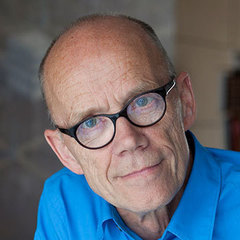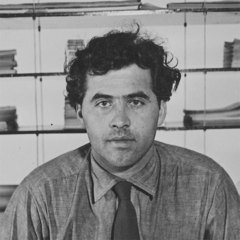Discover legacy content from FontShop.com, preserved for your reference.
You have an enormous printing workshop packed with extraordinary machines and all kinds of type. Can you talk us through what you have in your workshop?
I have a small proofing press, a Korrex Nürnberg 38 by 55 cm. It prints letterpress from wood or lead type, woodcuts, polymer plates or anything higher than its surroundings. I have lots of metal and wood type, from 8 point Akzidenz Grotesk to 33 line wood type, plus all the other stuff needed to set type. And also two table-top platen presses which in German we call Boston-Pressen.
Can you recall how your interest for paper, type and the smell of (ink) color — the aphrodisiacs of printing — first came into being?
Yes. When I was around seven or eight, we had a neighbour who was a printer. I remember him showing me a piece of white paper. Then he showed me a printing forme — some columns of type and all the furniture around it — which looked very complicated and messy to me: a lot of metal and ink. Then he took a proof from that forme onto the white paper, and like magic it showed only a few precise black marks, while the paper was still clean and white. Those marks were letters that I could read and the whole process was a miracle to me. That is when I fell for type and printing. Now I come back to that original technology of putting marks on paper: letterpress printing.



You had a printing workshop back in the seventies but unfortunately it caught fire. It must have been absolutely devastating … Now looking back with healed wounds: do you think there was something positive about it?
After my workshop, presses and type burnt down, I had only pencil and paper left, plus my brain and experience with type — all the tools a graphic designer needed at the time. I was forced into a career that I had no formal training for. And still don’t. But in a situation like that it didn’t matter. I just sketched type for other people to set and became knowledgable about photosetting and type design. Two years after the fire in 1977, I designed my first typeface for Berthold, LoType.

When working on a project for the press, what criteria do you have for choosing the right typeface? What are the differences with working on a computer?
If I had to print letterpress, longer text — which I would never do — but if I had to, obviously then you pick what you have and when I used to work in printing in the 60s and 70s, a printer had a certain amount of typefaces and you would pick from those. And if you didn’t have a 9 point you would pick 8 or 10 and make it fit somehow. That was both inhibiting and also at the same time … — maybe these days, I realize how liberating it was. Lack of choice just made your day a lot shorter because you just didn’t have to think about, you just took whatever was there.
Now of course we have all these choices and I’m spending a lot of time trying to keep updated with what’s going on and I have no hope of being updated at all ever. I have some friends, like Stephen Coles who is younger and therefore even more in touch than I am, but I call people, I ask people, I try to look at everything. When it comes to picking a typeface I still do what I always did, I look at the potential (font) size, the size of the page, the readership, the way it’s printed. Does it need to be heavy or light? Is there a lot of copy? Is it 9 and a half point, is it 10 point? And then you narrow down your choices and in the end you take something that fits the copy.
I just did a book that is kind of like a diary where somebody wrote about her parents who both lived in the 50s and 60s. So I didn’t want to use a nostalgic typeface because the 50s and 60s stuff was mostly ugly, but I didn’t want to do something that was too fashionable. Obviously it couldn’t be Bodoni or Helvetica, so I ended up using a typeface that was made for magazines/newspapers that looks fairly ordinary and has a little edge to it maybe and I picked a slightly heavy version which does exist and is not so thin on the paper. The paper is even a little yellowish, so the whole book has a slightly… not nostalgic, but period feel about it. It’s not brand new, it is not glossy white but it’s not nostalgic either. In the end it’s down to the length of copy, form and the size. I first set the book in 10 point on 14, and then it was just too long. It looked too big on the page, because of the page size given. So I went back to 9 and a half on 13, and it looked perfect. So it’s always a mix of things. There are also some faces I don’t like at all and some stuff I’ve always loved and I’m always waiting for an opportunity to use them. And luckily, this face is Lyon and I finally could use it.



Which typefaces don’t you like?
[link not found] [link not found]
I don’t like typefaces that everybody uses. I don’t like Helvetica, because it’s boring and it’s not a typeface, it’s an attitude. Or lack of attitude. And I would never use it in a million years except romantically. Ironically, I said to my wife, that I want my tombstone to be set in Rotis, because that would be ironic and my friends would get it. That is sort of the last word. And I don’t like mannered typefaces, those typefaces that are designed on a principle like Avant Garde Gothic. Everything is meant to be geometric. Those don’t work. Same as Rotis. I like the ones that are a new take on an old classic. Lyon is a take on Times. Like FF Scala is a take on Garamond — it’s not a re-creation, but it’s that same kind of thinking, it has the same kind of feel, it just makes it new. Not in details, it’s not about having a triangular serif or some corners cut off — it just has a different feel to it. I like bread. And I try different breads all the time, they’re all made from wheat or rye, but they are all slightly different. You don’t know what’s different but the taste is different. I don’t care how they make it. I just like the choices. In German we call it Brotschriften — the daily bread of type.
In a lot of your projects you use your own typefaces, such as FF Meta, FF Unit or FF Info. Do you sometimes miss them in your (metal) typecase? If so, do you want to do something about it?
No, I think they were made digitally and they should remain digital. It would be totally ridiculous to cast them in metal. I might have a text that would look good in one of those typefaces and then I would maybe make a polymer plate — a nyloprint as we call it in Germany. I don’t even think I’m going to print books because everybody prints books. I’m not sure what I’m going to be printing. I like bigger size stuff. It may just be words. Single letters, words. I like a poster that just says RGB — in black of course. That is some sort of stuff I want to do. I actually have a project where I want to print a series of sixty or a hundred three-letter words in English. And then you can make sentences from it. I might even do two-letter words. Or in German I might have to do twenty five-letter words, whatever. I’m just want to explore language, because if you print a word on a poster, it has a different life. It’s different from just writing on a piece of paper. People want it to make sense. If you put twenty words in front of somebody, they try to make sense. They try to build a sentence, because that’s how we are. We want to read stuff. That interests me. Using my own type is sometimes due, because they are there, I don’t have to pay for them anymore, I get a free sample when I license them through FontFont, and I know them well and they usually work. Sometimes it’s a little embarrassing like in this case with this book. I would have never done it in one of my typefaces. It would have been quite appropriate, but it’s kind of embarrassing. Oh yeah, here is Spiekermann using his own typefaces, bla bla bla, boring boring boring. No, it wouldn’t be right, just because it’s mine. I do use them whenever it’s appropriate but not all the time. There is too much stuff out there. It’s too boring using my own stuff.

But you have a wood type version of FF Meta, right?
Yes, a student from Vancouver cut it. There is only one letter each, so it’s going to be difficult to use it. Well, you can set “Hamburgerfonstiv” from it and some pangrams, where you have only one letter each. But I haven’t used it yet. I will do, now that I’ve got all the big machines together. I’m trying to move into a big space and then I’m going to have 5 proofing presses, or maybe 6 proofing presses. I think I’m going to get in the Guinness Book of Records for having the most proofing presses in one shop. And they are all going to be painted gray: RAL-Lichtgrau 7035, like this place.
You have a passion for numbering stamps. Can you tell us more about that?
Essentially, it is a little device that prints a number and then on the next print a plunger comes down, moves a number on a wheel and it prints the next number, so you’re numbering the prints that you do.
I like the mechanical device. It is incredibly beautiful. It has those generic numbers. It’s difficult to print because you really have to give it a lot of pressure, so the plunger goes down, and then moves to the next number. Also it means I keep track, because you always forget how many numbers you’ve printed. Was it a 110 or 120 I never know. This counts it. Also, if you’re printing letterpress, you do tend to print limited runs. And this is a good proof. Because you can’t forge that. Well, you can print 200 and then you can print 200 again, I guess. But for me it is a good reference and it’s genuine and I like the fact that it always looks a little messy. They’re very mechanic and I have 20 stamps and I’m going to buy another 20. Then I’m going to make a poster that has only 40 numbering stamps on it and they are all going to be set to a different number and they all change every time I print them, for instance, 20 to the power of 20 minus 1, which is pretty cool. So I have to print over a million posters before they repeat themselves.


The structure and layout of your house is pretty interesting and unusual for German conditions. It is rather narrow, tall and deep. Floors also separate the rooms, instead of walls. Are there any major benefits compared to living on a classical single floor layout with walls separating each area?
No, there are only disadvantages. A quarter of the house is taken up with staircases. It’s a total waste. This is the townhouse model that in Berlin we don’t usually have but some planner decided that this area will be rebuilt using the townhouse model that we have in Hamburg, or Bremen, or London, or Amsterdam, but not really in Berlin. So, we got one of these spaces and built a house and it’s 6 and half meters wide and 13 deep, so it’s a double square, which is kind of nice. And there is a limit of 22 meters tall in Berlin. So we managed to squeeze 7 floors in, while you’re allowed to do 5 floors, so we did 2 floors under full height, so they don’t count as floors. We actually have 8 floors, if you include the cellar. So you come in on floor 1, or floor 0 as we say it in Germany; 1 and 2 are rented to an office, so it gives me some income; floor 3 is the printing press and the washing machines and the storage and stuff; floor 4 is my studio, where we are now; and floor 5 is the living room/kitchen. Floor 6 is the bedroom. There are 7 floors altogether plus the basement. It’s a little wasteful but it’s interesting to run up and down, and it’s nice to have the division, so you have different kinds of spaces but it’s still very unpractical but kind of romantic. It is essentially a box. A Schubladenschrank, this is what this is.





You were pretty hard on Otl Aicher’s Rotis. You called it a “Kopfgeburt” — something that is born from the head and is not useful in application. Yet you actually own a Bulthaup kitchen, and funnily enough Otl Aicher was integral in shaping the design during the 80s and 90s. In your opinion was Aicher a better kitchen designer than a type designer?
Yes. Because a kitchen has a maybe romantic appeal but it is very practical. You can define the way a drawer works, where everything is. People have sort of all the same height and the same processes when you cook. You cut stuff up first, and you throw away rubbish and then you need to boil water. That is pretty obvious. Whereas a typeface is a lot more emotional. It is significant that Aicher helped to design kitchens but not design cooking. Because cooking is like designing type. The result is always different. You give the same ingredients to different people, it’ll come out different. Even if you give them the same amount of ingredients, it’ll come out different because you can cook longer or shorter, you can cut onions thick or thin, the same happens for type. It’s always A to Z but it looks different and Aicher had so much theory behind his letters that they became very unemotional. It’s almost like you would design a lab instead of a kitchen. A kitchen has still to be a little messy and there are elements in that kitchen we did ourselves and the way it is arranged. We use the elements from Bulthaup but we arranged it ourselves. I think kitchen design and letter design can’t be compared which is the mistake that people like Aicher always made. They thought that it’s something you can totally and utterly plan. But you can’t plan the emotional aspect of a curve or of letters when they come together. Because a letter doesn’t exist on its own. A knife does, but not a letter.



Alongside printing, you played bass in bars when you were studying. Now that you have revived your printing passion, when will we get the chance to see you performing bass on stage?
No, it won’t be bass. It’ll be guitar. I have a couple of guitars and I intend to get back into guitar playing next year when I retire. My Martin is over there and I have all the good intentions into playing guitar — and I will.

Photography by Max Zerrahn.




